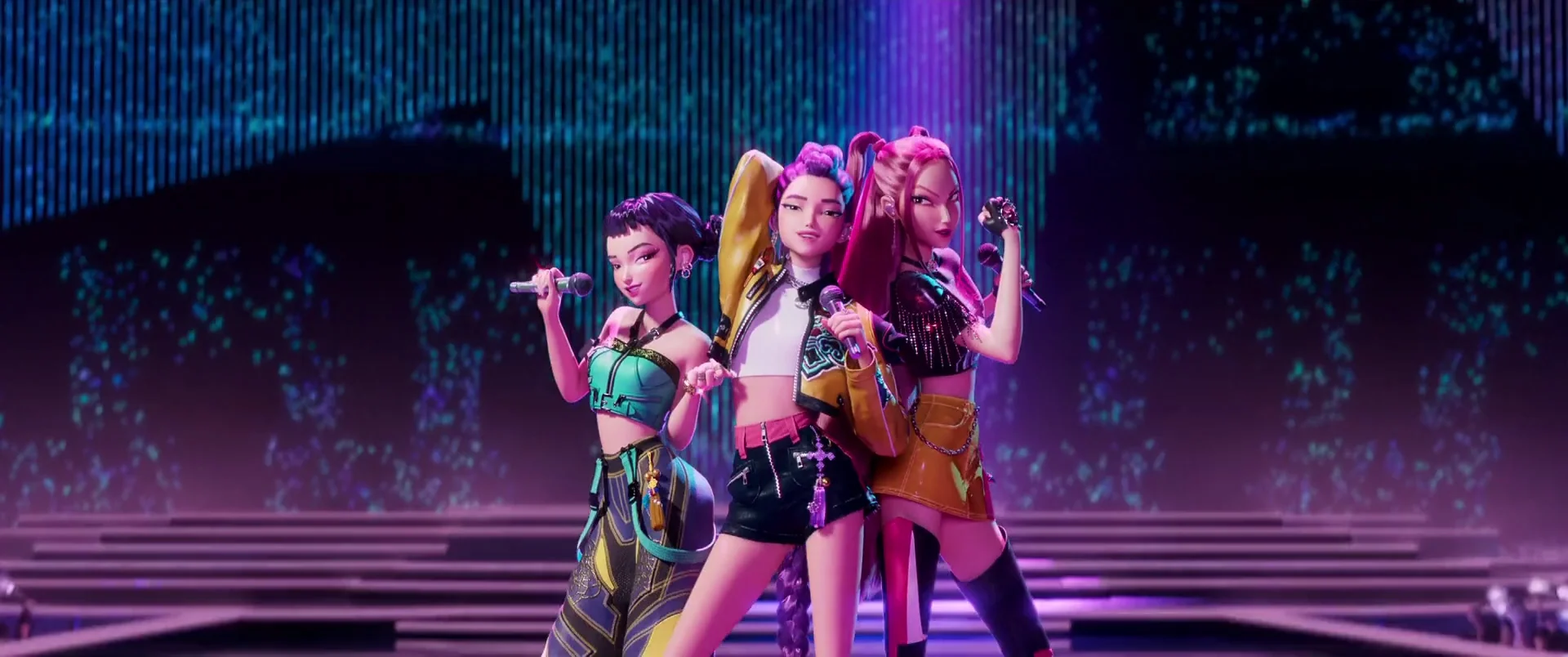Sealing the Honmoon: A KPop Demon Hunter’s Guide to Takedown Negative Self-Talk
Introduction: Why We Are All Part Demon
Image from The Hollywood Reporter
**Please note: The following narrative includes spoilers for KPop Demon Hunters*
If your household is anything like mine, KPop Demon Hunters has been playing on repeat at home, in the car, and even on the sidelines during soccer practice. At any given time, at least one member of my family is humming or singing one of the film’s songs, often loudly and very off-tune.
At face value, the popularity of the KPop Demon Hunters film may be baffling. The premise of the film is hard to describe without sounding a bit unhinged: A group of three strong women are KPop singers by day, and by night they… hunt demons in super sleek outfits. Oh, and there’s the part where a group of demons start a competing boy band. And in order to save the Honmoon — which is basically a magical shield around the world — the singers have to not only physically fight demons with weapons, but they also need to beat the boy band in a national singing competition.
Wild, right?
So why is it that children, teens and adults have all been pulled in by the appeal of the animated movie?
Granted, it is absolutely in large part due to what Rumi calls “annoyingly catchy” music. Four of the songs have landed in the Billboard’s Top 10. The song “Golden” even hit Number One.
However, there’s a bigger reason KPop Demon Hunters has taken over: It’s profoundly relatable.
The truth is we all battle with demons.
While we cannot all be KPop superstar singer hunters like Huntrix (no matter how much we may want to), we are in a constant battle with demons each day.
Our demons just take a different form. No, they aren’t giggle-inducing members of a demon boy band. No, they aren’t even malevolent, supernatural beings from the Demon Realm ruled over by Gwi-ma.
Instead, our demons take the form of our own thoughts. Our inner dialogue can feel like a demon whispering doubts and fears.
Some people hear them as a cruel whisper in the back of their mind—you’re not good enough, you’ll never measure up, why even try? Others feel them as heavy shadows that follow through the day, making every decision seem harder. Psychology has many names for this voice: negative self-talk, the inner critic, intrusive thoughts. But regardless of its name, these thoughts are rooted and driven by our own fears, doubt, shame, and despair.
In short, like Rumi, we are all part demon.
The secret to defeating our internal demon is not ridding ourselves of it; it’s recognizing these scars and voices are a natural and logical part of us. Our neverending crusade is allowing the darkness and light to live in harmony.
Only then can we seal the Honmoon inside of each of us.
Images from KPop Demon Hunters Wiki
Our Inner Demon: Understanding Negative Self-Talk
Before diving deeper, let’s further define the “demon” we’re really talking about. Negative self-talk is the inner dialogue that criticizes, doubts, and discourages. It’s the little voice that says:
I’ll never be as good as they are.
I always mess things up.
It’s my fault everyone is upset.
I should be smarter, stronger, better by now.
I’m such an idiot.
Why do I even bother trying?
The irony is this inner critical voice evolved as a way to keep us safe. It comes from a place of wanting to warn us and protect us from mistakes and rejection. In some ways, it’s a survival mechanism: if we pre-empt failure by criticizing ourselves, maybe others won’t hurt us first.
But over time, this protective critic grows overzealous. Instead of keeping us safe, it keeps us small.
When this voice gets too loud or repetitive, it becomes destructive. It can overpower the other voices inside that remind us of our unique strengths and capabilities.
When these thoughts start looping, they can feel less like a passing worry and more like a constant haunting presence. For many of us, this internal dialogue is one of the hardest battles we’ll ever face — not because it’s visible, but because it lives inside us.
Photo 1 Envato Monkey Business; Photo 2 Pexels Alex Green; Photo 3 Pexels Cottonbro Studio; Photo 4 Envato Image-Source
Practical Steps To “Takedown” Your Own Inner Demon: We Can’t Fix It If We Never Face It
Here is the good news: You actually do not need to slay or takedown the demon. You only need to face it and move forward.
When people first notice their inner demon, they often try to silence it. They argue back, shout over it, or suppress the thought. But paradoxically, this can make the demon louder.
This is because the more you try not to think about something, the more it dominates your mind. By battling the demon directly, you may end up feeding it.
This doesn’t mean you’re powerless. It means the strategy must change. Instead of trying to kill the demon, you can learn to face it, understand it, and even make peace with it.
Kpop demon hunters may live in fictional universes, but their struggles mirror our own. By naming, facing, learning from, and even dancing with our demons, we can transform negative self-talk into something more bearable.
Because thriving isn’t about living without demons. It’s about becoming strong and graceful enough to walk beside them.
Step One: Naming the Demon
In Kpop stories, hunters begin by identifying their enemy. We can do the same with self-talk. By externalizing the critic, you create distance.
Try this art therapy intervention: Write down a recurring negative thought. Then imagine what it would look like as a demon, monster or creature. Perhaps you even want to draw the demon, taking note of what it looks like, what color it may be, how it talks, where it lives, etc.
Most importantly, give it a name. Suddenly, it’s no longer you; it’s something you can face. Think of it like turning on the lights in a dark room. Shadows lose their power once you can see their outlines.
Photo Pexels Julio Lopez
Step Two: Facing the Demon Without Fear — The Power to Respond
In hunter-versus-demon showdowns, hesitation and fear are part of the story. Victory doesn’t come instantly, and that’s okay.
The same goes for your inner critic. Instead of trying to silence it, practice noticing it without fear or judgement. When it says, You’re not good enough, you can respond: I hear you AND I’m moving forward anyway.
Mindfulness practices teach us to observe thoughts without judgment. Instead of being the thought (“I’m a failure”), you label it as what it is: “I’m having the thought that I’m a failure.”
This psychological skill is called thought catching and challenging: seeing your thoughts for what they are, just thoughts.
Thoughts are not truths. They are not facts. And when we recognize them for what they truly are — just thoughts — we can practice other ways of thinking and being.
Try this art therapy intervention: Now that we have our Negative Thought Demon/Monster/Creature, imagine what the demon’s arch nemesis would be. This is the natural counterweight to the enemy: The Hunter side. Is it a superhero? A powerful dragon? The face of your best friend? Or maybe a strongwilled Kpop singer with a pet derpy tiger?
Whoever or whatever it may be — imagine what this Hunter looks like and consider drawing it. What color is it? Does it have any super powers? Where does it live? Remember, give it a name. And most importantly, consider what it would say to the Negative Thought Demon while engaging in battle.
This voice will be encouraging, reminding us to take risks, and celebrate wins. This is the voice that inspires us to keep going when things get tough. It may say things like:
While this may seem hard, you can do this!
This seems impossible, but you’ve done challenging things before too.
It may not be perfect, but you tried your best.
I might feel nervous, but I can still show up.
I can admire other people’s strengths, but recognize I’m growing too.
Regardless of what this Hunter side says, remember that it, as well as the Negative Thought Demon live within you. And that’s okay.
Clockwise: Pexels Lum3n; Envato BrianAJackson; Pexels Cottonbro Studio; Pexels Magda Ehlers
Step Three: Dancing and Singing With the Demon
Just as Rumi comes to a place of accepting both her demon and hunter side, we can allow ourselves the ability to integrate: recognizing how the demon is an ally or a source of strength in trying to protect us.
Ask yourself: What is my inner critic trying to protect me from?
A perfectionist voice may reflect your value for excellence.
A fearful voice may be reminding you to prepare.
A jealous voice may be pointing toward your need for belonging.
Once you see the kernel of truth, you can honor it without letting the cruelty of the delivery run the show.
This is the ultimate metaphor: sometimes the way forward isn’t to kill the demon, but to dance with it. The demon voice will always return at stressful moments. But instead of fearing it, you learn to move with it.
Think of performers who admit to stage fright, yet still step on stage. The demon whispers, “You’ll fail.” They nod, take a breath, and perform anyway.
Your goal isn’t to silence the demon forever, but to build resilience in its presence. The demon may always be part of you, but it no longer defines you.
In practice, this might mean:
Turning perfectionism into motivation for steady practice.
Using anxiety as fuel for preparation, while not letting it define you.
Accepting that the critic will show up at big moments—and performing anyway.
Image 1 The Banner.com; Image 2 & 4 Kpop Demon Hunters Wiki; Image 3 YouTube
Finding Harmony: Let the Jagged Edges Meet the Light
Let’s be real: Our negative voices will never disappear.
While Jinu may have made a deal with Gwi-Ma in order to make his own interval voices disappear, this was never going to happen. Nor do we want it to. Remember, our internal dialogue is not supposed to disappear because it is trying to serve a purpose of protecting you, albeit often unhelpfully.
If we think the goal is to “takedown” negative self-talk, we’ll always be disappointed. We may even feel more shameful and guilty. But if we aim for harmony and acceptance — acknowledging the demon, facing it, even drawing strength from it — we step into a healthier relationship with ourselves.
We learn to see the beauty in the broken glass.
Like Kpop demon hunters, we learn that light and shadow exist together. Our demons don’t make us broken; they make us human.
Photo 1 Pexels Alex Green; Photo 2 Pexels Alexander Grey; Photo 3 Pexels Hyukman Kwon
How It’s Done: Practical Takeaways and “Golden” Tools for Daily Life
Here are strategies to tame (and not defeat) the inner demon:
Journaling – Write down the demon’s words. Then, in another column, write a gentler, more realistic reply.
Mindfulness meditation – Practice observing thoughts like passing clouds, without judgment.
Self-compassion exercises – Speak to yourself the way you’d speak to a friend.
Creative expression – Draw, dance, or write your demon. Turning it into art takes away some of its sting.
Therapy - Cognitive Behavioral Therapy (CBT) and ACT are both effective in addressing negative self-talk.
Remember, none of us are out here on our own. The therapists at Patch Counseling are here with you to dive into the fire and be here right by your side.
Photo 1 Pexels Pixabay; Photo 2 Pexels Suraphat Nuea-on; Photo 3 Pexels ATC Comm Photo; Photo 4 Pexels Marcos Alberto García Urrea; Photo 5 Pexels Polina Tankilevitch
THIS ARTICLE WAS WRITTEN BY BRITTANY BENJAMIN AMANTE, LMFT + ATR
Brittany supports preteens and teens, ages 12–16, who are navigating the academic, social, and emotional challenges of adolescence, including anxiety, depression, ADHD, and family conflict. With training in Clinical Art Therapy, EMDR, and TBRI, she uses creativity, compassion, and collaboration to provide trauma-informed care. Her goal is to help clients build resilience, strengthen identity, and foster deeper connections with themselves and others.
At Patch Counseling, we’ll help you find your inner Hunter voice, face your demons with courage, and dance with them instead of running away.
Images Clockwise 1 Reddit; 2 Tudum by Netflix; 3 Polygon; 4 Reddit; 5 ScreenRant
You can find KPop Demon Hunters on Netflix
-
In the film, sealing the Honmoon protects the world from chaos. In real life, it’s a metaphor for strengthening your own emotional boundaries — finding balance between your light and dark sides so you can live with greater peace and self-acceptance.
-
It becomes concerning when that inner critic feels constant, cruel, or paralyzing — especially if it starts affecting your motivation, sleep, or relationships. Occasional self-doubt is normal; nonstop self-attack is not. That’s when reaching out for help can make a huge difference.
-
Silencing often means pushing thoughts away — which tends to make them louder. Facing your inner critic means acknowledging it, identifying where it comes from, and responding with compassion instead of fear. It’s about transforming the relationship, not erasing it.
-
Both! Kids, teens, and adults can all benefit from visualizing their “demon” and “hunter” sides. It’s a fun, creative way to make the abstract idea of negative self-talk more concrete — and to begin understanding and softening it.
-
Therapy gives you tools to notice, challenge, and reframe your inner dialogue. Approaches like CBT (Cognitive Behavioral Therapy) and ACT (Acceptance and Commitment Therapy) teach you how to respond to your inner critic with awareness and self-compassion — the same way a KPop hunter learns to work with their demon instead of against it.















